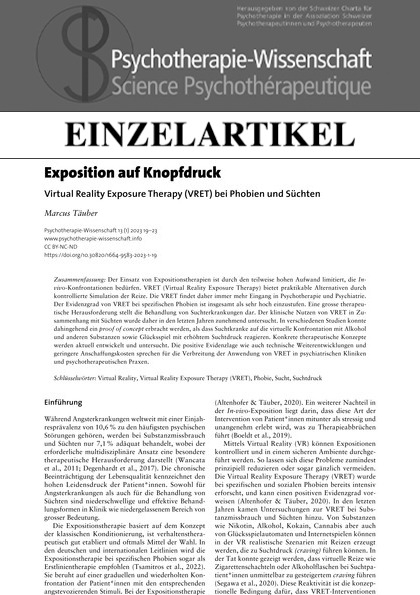Exposure by pressing a button
Virtual Reality Exposure Therapy (VRET) for phobias and addictions
DOI:
https://doi.org/10.30820/1664-9583-2023-1-19Keywords:
virtual reality, virtual reality exposure therapy (vret), review, phobia, addiction, cravingAbstract
Absract: The use of exposure therapies is limited by the sometimes high effort that in vivo confrontations require. VRET (Virtual Reality Exposure Therapy) offers viable alternatives through controlled simulation of stimuli. VRET is therefore increasingly finding its way into psychotherapy and psychiatry. The overall level of evidence for VRET in specific phobias can be classified as very high. A major therapeutic challenge is the treatment of addictive disorders. The clinical benefit of VRET in the context of addictions has therefore been increasingly investigated in recent years. In various studies, a proof of concept could be shown that addicts react to the virtual confrontation with alcohol and other substances as well as gambling with increased addictive pressure. Concrete therapeutic concepts are currently being developed and investigated. The positive evidence base as well as technical advancements and lower acquisition costs speak for the spread of the application of VRET in psychiatric clinics and psychotherapeutic practices.
Downloads
How to Cite
Täuber, M. (2023). Exposure by pressing a button: Virtual Reality Exposure Therapy (VRET) for phobias and addictions. Psychotherapie-Wissenschaft, 13(1), 19–23. https://doi.org/10.30820/1664-9583-2023-1-19
Issue
Section
Special Issue
License

This work is licensed under a Creative Commons Attribution-NonCommercial-NoDerivatives 3.0 Unported License.
This journal provides open access to its content in accordance with the basic premise that the free public availability of research benefits the exchange of knowledge throughout the world.
Authors wishing to publish in this journal agree to the following:
- The author/s retain/s the copyrights and consent/s to initial publication of the work in the journal under a Creative Commons Attribution licence, which allows third parties to use the work by citing the name/s of the author/s and this journal as initial publisher (in accordance with the Creative Commons Attribution-NonCommercial-NoDerivs 3.0 DE-Licence).
- The author/s can enter into additional contracts for the non-exclusive distribution (e.g. publish in a collection or book) of the version published in the journal, if the journal is cited as initial publisher.


